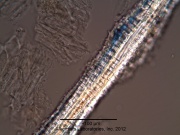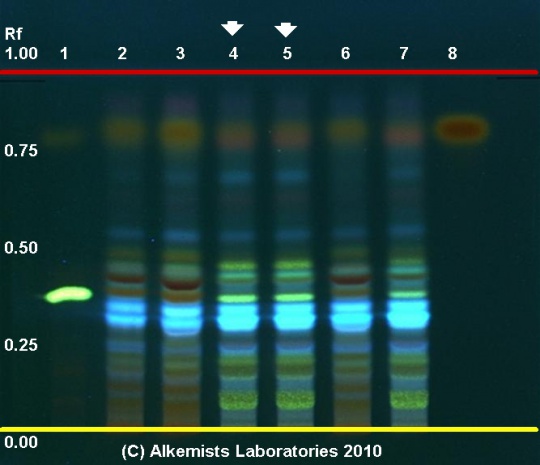Frangula purshiana (bark)
m (moved Rhamnus purshiana (bark) to Frangula purshiana (bark): ARS-GRIN Nomenclature update) |
(→USD) |
||
| Line 10: | Line 10: | ||
''The quoted text in this section was licensed for use under the Creative Commons ShareAlike License, version 3.0: http://creativecommons.org/licenses/by-sa/3.0/'' | ''The quoted text in this section was licensed for use under the Creative Commons ShareAlike License, version 3.0: http://creativecommons.org/licenses/by-sa/3.0/'' | ||
=Macroscopic Entries= | =Macroscopic Entries= | ||
| + | |||
| + | {{Macroscopy | source=United States Dispensatory (1918) | ||
| + | | description=''Rhamnus Purshiana'' is a small tree, attaining a height of twenty | ||
| + | feet. Its leaves are rather thin, elliptic, for the most part briefly acutely | ||
| + | pointed, finely serrated, at the base obtuse, somewhat pubescent | ||
| + | beneath, from two to seven inches long and from one to three wide. The | ||
| + | rather large flowers are in somewhat umbellate cymes; the sepals five; | ||
| + | the minute cucullate petals bifid at the apex. The fruit is black, broadly | ||
| + | obovoid, four lines long, three-lobed, and three-seeded. The seeds are | ||
| + | convex on the back, with a lateral raphe. | ||
| + | |||
| + | Usually in flattened or transversely curved pieces, | ||
| + | occasionally in quills; bark from 1 to 5 mm. in thickness; outer surface | ||
| + | dark brown or brownish-red, longitudinally ridged, often nearly covered | ||
| + | with grayish or whitish lichens, bearing small blackish apothecia, | ||
| + | sometimes with numerous lenticels, and occasionally with mosses; inner | ||
| + | surface light yellow, light brown, or reddish-brown, longitudinally | ||
| + | striate, turning red when moistened with solutions of the alkalies; | ||
| + | fracture short, with projections of bast-fibers in the inner bark; in cross | ||
| + | section inner bark shows diagonal or curved medullary rays, forming | ||
| + | converging groups, the outer bark showing yellowish groups of stone | ||
| + | cells which are especially apparent on moistening the freshly cut surface | ||
| + | with phloroglucinol T.S. and hydrochloric acid; odor distinct; taste | ||
| + | disagreeable, bitter, and slightly acrid. | ||
| + | |||
| + | In quilled, channelled, or nearly flat pieces from one to two millimetres | ||
| + | thick, but varying in length and width. Cork nearly smooth, dark | ||
| + | purplish-brown, marked with transversely elongated lenticels, but | ||
| + | usually more or less covered with patches of silvery-grey lichen. Inner | ||
| + | surface reddish-brown, with faint transverse corrugations and | ||
| + | longitudinal striations. Fracture short, but near the inner surface | ||
| + | somewhat fibrous. In transverse section, scattered groups of | ||
| + | sclerenchymatous cells in both cortex and bast; the parenchymatous | ||
| + | cells contain a yellow substance which is colored violet by solution of | ||
| + | sodium hydroxide. Odor characteristic but not powerful; taste nauseous, | ||
| + | bitter and persistent. | ||
| + | }} | ||
=Microscopic Entries= | =Microscopic Entries= | ||
| + | {{Microscopy | source=United States Dispensatory (1918) | ||
| + | | description=''Rhamnus Purshiana'' | ||
| + | |||
| + | Under the microscope, a | ||
| + | transverse section of Cascara Sagrada shows an outer yellowish-brown | ||
| + | or reddish-brown corky layer consisting of 10 to 15 or more rows of cells; | ||
| + | stone cells in outer bark in tangentially elongated groups of 20 to 50 | ||
| + | cells, the walls being very thick and finely lamellated; medullary rays 1 | ||
| + | to 4 cells wide, 15 to 25 cells deep, the contents being colored red upon | ||
| + | the addition of solutions of the alkalies to the sections; bast-fibers in | ||
| + | tangentially elongated groups in the inner bark, the walls being thick | ||
| + | and strongly lignified; crystal fibers around the bast-fibers with | ||
| + | individual crystals from 0.008 to 0.015 mm. in length; parenchyma with | ||
| + | spheroidal starch grains about 0.003 to 0.008 mm. in diameter, or with | ||
| + | calcium oxalate either in rosette aggregates or prisms from 0.01 to 0.02 | ||
| + | mm. in diameter. Add 0.1 Gm. of powdered Cascara Sagrada to 10 mils | ||
| + | of hot water, shake the mixture occasionally until cold, filter it and add | ||
| + | sufficient water to make 10 mils; on the addition of 10 mils of ammonia | ||
| + | water to this liquid, it is colored an orange-yellow. Macerate 0.1 Gm. of | ||
| + | powdered Cascara Sagrada with 10 drops of alcohol, boil the mixture | ||
| + | with 10 mils of water, when cold filter it and shake the filtrate with 10 | ||
| + | mils of ether; a yellow ethereal solution separates. Shake 3 mils of this | ||
| + | ethereal solution with 3 mils of ammonia water; the separated | ||
| + | ammoniacal solution still possesses, on diluting with 20 mils of water, a | ||
| + | distinct, yellowish-red color. The powder is light brown to olive brown, | ||
| + | showing characteristic elongated groups of bast-fibers associated with | ||
| + | crystal fibers, the crystals in the latter being in the form of monoclinic | ||
| + | prisms from 0.008 to 0.015 mm. in length; stone cells in large groups, the | ||
| + | cells having thick and finely porous walls; fragments of parenchyma | ||
| + | and medullary ray cells colored red upon the addition of solutions of the | ||
| + | alkalies; starch grains either free or in parenchyma cells, the individual | ||
| + | grains being somewhat spheroidal, from 0.003 to 0.008 mm. in diameter; | ||
| + | calcium oxalate in monoclinic prisms or rosette aggregates from 0.01 to | ||
| + | 0.02 mm. in diameter; occasional fragments of reddish-brown cork. | ||
| + | |||
| + | The medullary rays in ''R. Purshiana'' are | ||
| + | numerous, thin, for a long distance nearly parallel and straight | ||
| + | (according to L. E. Sayre, they converge .at their outer ends), run nearly | ||
| + | three-quarters of the distance through the bark, and are commonly | ||
| + | composed of two rows of cells. | ||
| + | |||
| + | ''R. Frangula'' contains no stone cells. | ||
| + | }} | ||
| + | |||
{{Microscopy | source=Elan M. Sudberg, Alkemist Laboratories | {{Microscopy | source=Elan M. Sudberg, Alkemist Laboratories | ||
| companyimage= AP-LOGO-Laboratories Crop - Copy.jpg | | companyimage= AP-LOGO-Laboratories Crop - Copy.jpg | ||
Revision as of 18:54, 7 January 2014
Contents |
Introduction
Introduction from Wikipedia, the free encyclopedia (http://en.wikipedia.org/wiki/Rhamnus_purshiana, retrieved 02/27/2012).
Rhamnus purshiana (Cascara Buckthorn, Cascara, Bearberry, and in the Chinook Jargon, Chittam or Chitticum; syn. Frangula purshiana, Rhamnus purshianus) is a species of buckthorn native to western North America from southern British Columbia south to central California, and inland to western Montana.
It is the largest species of buckthorn, occasionally growing up to 15 m tall, though more commonly a large shrub or small tree 5–10 m tall, with a trunk 20–50 cm in diameter. The bark is brownish to silver-grey with light splotching. The leaves are deciduous, alternate, clustered near the ends of twigs; they are oval, 5–15 cm long and 2–5 cm broad with a 0.6–2 cm petiole, dark shiny green on top, fuzzy and paler green below. The flowers are tiny, 4–5 mm diameter, with five greenish yellow petals; the flowering season is brief, disappearing by early summer. The fruit is a berry 6–10 mm diameter, bright red at first, quickly maturing deep purple or black, and containing three seeds.
It grows in moist, acidic soils in the shady side of clearings or in the marginal forest understory, near the edges of mixed deciduous-coniferous forests. It typically grows as a second-generation tree after alders have colonized a barren plot of land.
The quoted text in this section was licensed for use under the Creative Commons ShareAlike License, version 3.0: http://creativecommons.org/licenses/by-sa/3.0/
Macroscopic Entries
|
Microscopic Entries
|
|
HPTLC Entries
|
Cascara (bark) (Rhamnus purshiana) Lane Assignments Lanes, from left to right (Track, Volume, Sample):
Reference materials used here have been authenticated by macroscopic, microscopic &/or TLC studies according to the reference source cited below held at Alkemists Pharmaceuticals, Costa Mesa, CA. Stationary Phase Silica gel 60, F254, 10 x 10 cm HPTLC plates Mobile Phase ethyl acetate: methanol: water [10/1.35/1] Sample Preparation Method 0.3 g + 3 ml CH3OH sonicate/heat @ 50° C ~ 1/2 hr Detection Method Natural Product Reagent + PEG -> UV 365 nm Reference see Plant Drug Analysis, Wagner, H., 1996
|
Other Points of Interest
Cite error: <ref> tags exist, but no <references/> tag was found


